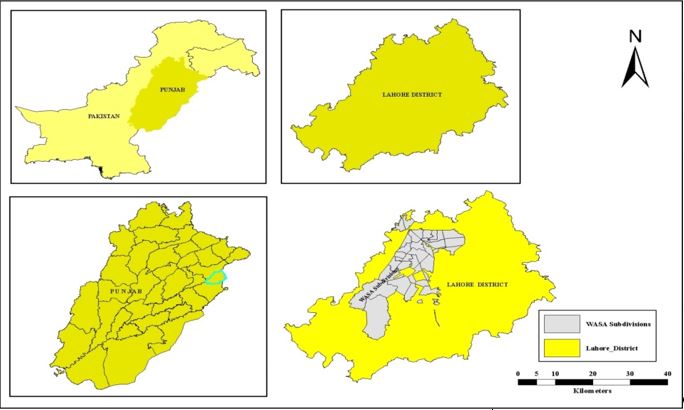Impact Assessment of Monsoon Precipitation on Groundwater Level in Lahore District GEE Script
Keywords:
Assessment, Ground Water Level, Lahore, Monsoon, Hydrology, SpatiotemporalAbstract
Introduction/Importance of Study: Precipitation is a crucial component of the global water cycle and a primary source of freshwater, with groundwater being vital for drinking water worldwide, especially in regions like Lahore, Pakistan, where it supports 60-70% of the population.
Novelty Statement: This study uniquely addresses the impact of monsoon precipitation on groundwater levels in Lahore, providing a comprehensive analysis that has not been previously undertaken.
Material and Method: Data from the Pakistan Meteorological Department and WASA’s hydrology branch (2018-2022) were analyzed using GIS-based Inverse Distance Weighted Interpolation and statistical methods to assess precipitation patterns and groundwater levels.
Result and Discussion: The findings indicate that monsoon rainfall significantly raises groundwater levels by 2-3 meters due to seepage and infiltration. Spatial and temporal analyses revealed that the monsoon period, especially July and August, contributes the most to groundwater recharge. Despite this, the overuse of groundwater during non-monsoon months and extensive urban infrastructure limit overall groundwater recharge. The study found a positive correlation between monsoon precipitation and groundwater levels, emphasizing the critical role of sustainable aquifer management to maintain groundwater resources.
Concluding Remarks: Sustainable management of aquifer recharge is essential to ensure the long-term availability of groundwater resources in Lahore.
References
A. Y. Hou et al., “The Global Precipitation Measurement Mission,” Bull. Am. Meteorol. Soc., vol. 95, no. 5, pp. 701–722, May 2014, doi: 10.1175/BAMS-D-13-00164.1.
N. Carrard, T. Foster, and J. Willetts, “Groundwater as a Source of Drinking Water in Southeast Asia and the Pacific: A Multi-Country Review of Current Reliance and Resource Concerns,” Water 2019, Vol. 11, Page 1605, vol. 11, no. 8, p. 1605, Aug. 2019, doi: 10.3390/W11081605.
M. S. Javaid, L. Khalid, M. Z. Khalid, M. S. Javaid, L. Khalid, and M. Z. Khalid, “Analytical Study of Environmental Impacts and Their Effects on Groundwater Hydrology,” Groundw. Hydrol., Mar. 2020, doi: 10.5772/INTECHOPEN.88002.
“Groundwater levels susceptibility to degradation in Lahore Metropolitan.” Accessed: Jun. 11, 2024. [Online]. Available: https://www.researchgate.net/publication/257317564_Groundwater_levels_susceptibility_to_degradation_in_Lahore_Metropolitan
M. Basharat, “Spatial and temporal appraisal of groundwater depth and quality in LBDC command-issue,” Pakistan J. Eng. Appl. Sci., vol. 11, no. June, pp. 14–29, 2012.
“Managing Groundwater Resources in Pakistan’s Indus Basin.” Accessed: Jul. 13, 2024. [Online]. Available: https://www.worldbank.org/en/news/feature/2021/03/25/managing-groundwater-resources-in-pakistan-indus-basin
G. Konapala, A. K. Mishra, Y. Wada, and M. E. Mann, “Climate change will affect global water availability through compounding changes in seasonal precipitation and evaporation,” Nat. Commun. 2020 111, vol. 11, no. 1, pp. 1–10, Jun. 2020, doi: 10.1038/s41467-020-16757-w.
V. Davamani et al., “A Critical Review of Climate Change Impacts on Groundwater Resources: A Focus on the Current Status, Future Possibilities, and Role of Simulation Models,” Atmos. 2024, Vol. 15, Page 122, vol. 15, no. 1, p. 122, Jan. 2024, doi: 10.3390/ATMOS15010122.
S. Salma, S. Rehman, and M. A. Shah, “Rainfall Trends in Different Climate Zones of Pakistan,” Pakistan J. Meteorol., vol. 9, 2012.
“Lahor’s Ground Water Depletion-A Review of the Aquifer Susceptibility to Degradation and its Consequences.” Accessed: Jun. 11, 2024. [Online]. Available: https://tj.uettaxila.edu.pk/older-issues/2015/No1/Lahore’s Groundwater Depletion-A Review.pdf
S. O. Owuor et al., “Groundwater recharge rates and surface runoff response to land use and land cover changes in semi-arid environments,” Ecol. Process., vol. 5, no. 1, Dec. 2016, doi: 10.1186/S13717-016-0060-6.
Z. Şen, “Unconfined Aquifers,” Pract. Appl. Hydrogeol., pp. 209–278, 2015, doi: 10.1016/B978-0-12-800075-5.00004-2.
C. Ingrao, R. Strippoli, G. Lagioia, and D. Huisingh, “Water scarcity in agriculture: An overview of causes, impacts and approaches for reducing the risks,” Heliyon, vol. 9, no. 8, p. e18507, Aug. 2023, doi: 10.1016/J.HELIYON.2023.E18507.
A. S. Qureshi, Z. U. Ahmad, and T. J. Krupnik, “Moving from Resource Development to Resource Management: Problems, Prospects and Policy Recommendations for Sustainable Groundwater Management in Bangladesh,” Water Resour. Manag., vol. 29, no. 12, pp. 4269–4283, Sep. 2015, doi: 10.1007/S11269-015-1059-Y/METRICS.
W. Ahmed et al., “Statistical Analysis of Climate Trends and Impacts on Groundwater Sustainability in the Lower Indus Basin,” Sustain., vol. 16, no. 1, p. 441, Jan. 2024, doi: 10.3390/SU16010441/S1.
S. H. Ahmadi and A. Sedghamiz, “Geostatistical analysis of spatial and temporal variations of groundwater level,” Environ. Monit. Assess., vol. 129, no. 1–3, pp. 277–294, Jun. 2007, doi: 10.1007/S10661-006-9361-Z.
“Particulars Functions & Duties | WASA, Lahore.” Accessed: Jul. 13, 2024. [Online]. Available: https://wasa.punjab.gov.pk/node/97
“Prequalification Document Preparation of Master Plan for Water Supply, Sewerage & Drainage System of Lahore,” 2014, Accessed: Jul. 13, 2024. [Online]. Available: www.lda.gop.pk
“GoP. (2000). District Census Report of Lahore 2017. Population Census Organization, Statistics Division Islamabad: Govt. of Pakistan”, [Online]. Available: http://www.pbscensus.gov.pk
“Study area and the geographical locations of WASA tubewells | Download Scientific Diagram.” Accessed: Jul. 13, 2024. [Online]. Available: https://www.researchgate.net/figure/Study-area-and-the-geographical-locations-of-WASA-tubewells_fig1_309278488

Downloads
Published
How to Cite
Issue
Section
License
Copyright (c) 2024 50SEA

This work is licensed under a Creative Commons Attribution 4.0 International License.




















